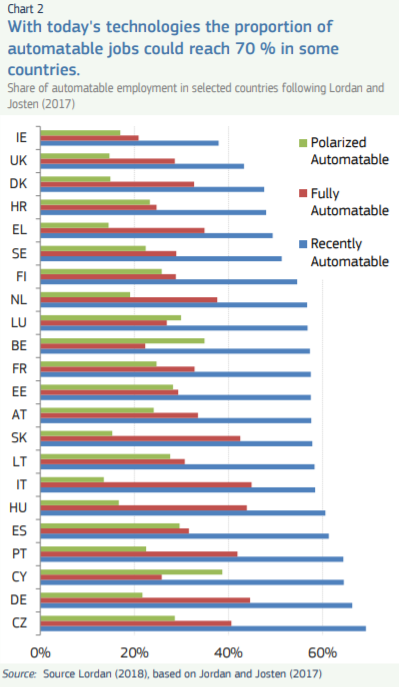Résumé des études sur l’emploi disponible en ligne.
We examine how susceptible jobs are to computerisation. To assess this, we begin by implementing a novel methodology to estimate the probability of computerisation for 702 detailed occupations, using a Gaussian process classifier. Based on these estimates, we examine expected impacts of future computerisation on US labour market outcomes, with the primary objective of analysing the number of jobs at risk and the relationship between an occupation’s probability of computerisation, wages and educational attainment. According to our estimates, about 47 percent of total US employment is at risk. We further provide evidence that wages and educational attainment exhibit a strong negative relationship with an occupation’s probability of computerisation.
Based on a European application of Frey & Osborne (2013)’s data on the probability of job automation across occupations, the proportion of the EU work force predicted to be impacted significantly by advances in technology over the coming decades ranges from the mid-40% range (similar to the US) up to well over 60%.
In recent years, there has been a revival of concerns that automation and digitalisation might after all result in a jobless future. The debate has been fuelled by studies for the US and Europe arguing that a substantial share of jobs is at “risk of computerisation”. These studies follow an occupation-based approach proposed by Frey and Osborne (2013), i.e. they assume that whole occupations rather than single job-tasks are automated by technology. As we argue, this might lead to an overestimation of job automatibility, as occupations labelled as high-risk occupations often still contain a substantial share of tasks that are hard to automate. Our paper serves two purposes. Firstly, we estimate the job automatibility of jobs for 21 OECD countries based on a task-based approach. In contrast to other studies, we take into account the heterogeneity of workers’ tasks within occupations. Overall, we find that, on average across the 21 OECD countries, 9 % of jobs are automatable. The threat from technological advances thus seems much less pronounced compared to the occupation-based approach. We further find heterogeneities across OECD countries. For instance, while the share of automatable jobs is 6 % in Korea, the corresponding share is 12 % in Austria. Differences between countries may reflect general differences in workplace organisation, differences in previous investments into automation technologies as well as differences in the education of workers across countries.
About half the activities people are paid almost $15 trillion in wages to do in the global economy have the potential to be automated by adapting currently demonstrated technology, according to our analysis of more than 2,000 work activities across 800 occupations. While less than 5 percent of all occupations can be automated entirely using demonstrated technologies, about 60 percent of all occupations have at least 30 percent of constituent activities that could be automated. More occupations will change than will be automated away.
Technically automatable activities touch 1.2 billion workers and $14.6 trillion in wages. China, India, Japan, and the United States constitute over half.
Automation’s boost to global productivity could be 0.8–1.4% annually over decades.
A particular focus of this new edition of the report is on arriving at a better understanding of the potential of new technologies, including automation and algorithms, to create new high-quality jobs and vastly improve the job quality and productivity of the existing work of human employees. As has been the case throughout economic history, such augmentation of existing jobs through technology is expected to create wholly new tasks—from app development to piloting drones to remotely monitoring patient health to certified care workers—opening up opportunities for an entirely new range of livelihoods for workers. At the same time, however, it is also clear that the Fourth Industrial Revolution’s wave of technological advancement is set to reduce the number of workers required for certain work tasks.
In 2018, an average of 71% of total task hours across the 12 industries covered in the report are performed by humans, compared to 29% by machines. By 2022 this average is expected to have shifted to 58% task hours performed by humans and 42% by machines.
In 2018, in terms of total working hours, no work task was yet estimated to be predominantly performed by a machine or an algorithm. By 2022, this picture is projected to have somewhat changed, with machines and algorithms on average increasing their contribution to specific tasks by 57%. For example, by 2022, 62% of organization’s information and data processing and information search and transmission tasks will be performed by machines compared to 46% today.
2.3: Job displacement through machines could be significant – two concepts
Autor and Dorn (2013) define ‘routine task intensity’ (RTI) for occupations. Three types of tasks are distinguished: Routine tasks involve a predictable sequence of actions which are easily codifiable. Replacement of people by machines is relatively easy in this case. Conversely, manual tasks require actions that are not generally predictable, so substitution with technology has so far been limited. Abstract tasks require high-level thinking that is complementary with technology. Therefore, many routine tasks, but few manual and few abstract tasks involve low RTI. An occupation is defined as automatable if its RTI is in the top 30% of all occupations. Based on the Autor-Dorn definition, Lordan (2018) calculates the share of automatable jobs for the decades starting in 1990, 2000 and 2010.

